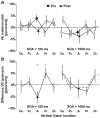Multisensory perceptual learning reshapes both fast and slow mechanisms of crossmodal processing
- PMID: 21264643
- PMCID: PMC3085990
- DOI: 10.3758/s13415-010-0006-x
Multisensory perceptual learning reshapes both fast and slow mechanisms of crossmodal processing
Abstract
Previous research has shown that sounds facilitate perception of visual patterns appearing immediately after the sound but impair perception of patterns appearing after some delay. Here we examined the spatial gradient of the fast crossmodal facilitation effect and the slow inhibition effect in order to test whether they reflect separate mechanisms. We found that crossmodal facilitation is only observed at visual field locations overlapping with the sound, whereas crossmodal inhibition affects the whole hemifield. Furthermore, we tested whether multisensory perceptual learning with misaligned audio-visual stimuli reshapes crossmodal facilitation and inhibition. We found that training shifts crossmodal facilitation towards the trained location without changing its range. By contrast, training narrows the range of inhibition without shifting its position. Our results suggest that crossmodal facilitation and inhibition reflect separate mechanisms that can both be reshaped by multisensory experience even in adult humans. Multisensory links seem to be more plastic than previously thought.
Figures





References
-
- Bauer BB. Phasor analysis of some stereophonic phenomena. The Journal of the Acoustical Society of America. 1961;33(11):1536–1539.
MeSH terms
Grants and funding
LinkOut - more resources
Full Text Sources

